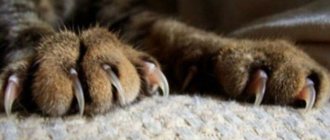Let's figure out why cats damage furniture and how to stop it.
Scratched furniture, torn sofa and wallpaper... Many cat owners know this firsthand. Coming home from work or waking up in the morning, you discover that your favorite furniture has suffered another damage. No investigation needed: there is only one suspect in this case - your cat.
So why does your pet scratch furniture? Below you will find several expert-tested ways to prevent your pet from ruining the upholstery of your favorite sofa.
Why do cats scratch furniture?
According to Jackson Galaxy, an expert on cat behavior and health and a writer for The New York Times, it's nature's way. This behavior is not limited to domestic cats: wild animals, for example, scratch trees. “By making scratches, they leave a mark on their territory, as well as a scent marker - scent glands are located between the pads on the furry paws,” the expert explained.
Disney
According to Galaxy, scratching helps cats exercise the muscles in their paws and chest, as well as get rid of dead scales that have built up on their claws. This is how representatives of the cat family maintain their beauty and sharpness.
However, this information does not make the task easier for owners who find it difficult to put up with damaged furniture.
So how do you stop a cat?
How to finish the surface
Due to the fact that wallpaper may lose its presentable appearance, sooner or later repairs will still need to be performed. And, if you haven’t managed to stop pets from sharpening their claws on walls and furniture, you should think about materials for decorating the interior of a house or apartment.
Professionals advise purchasing a special solution that repels cats, which can be used to treat not only wallpaper on the wall, but also any other materials. However, it should be taken into account that there are a number of surfaces that are completely uninteresting in the quality of the scratching procedure.
If you are an ardent fan of domestic animals and want to protect your renovation, think about purchasing finishing materials that react mediocrely to external influences. Such materials include: ceramic tiles, fiberglass wallpaper, decorative stone surfaces, PVC material, as well as plastic surfaces. The surfaces of upholstered furniture are usually protected with thick covers and sofa decks.
Method 1. Buy a scratching post
They can be found in every pet store. "Having several scratching posts in your apartment will increase the likelihood that your cats will use them instead of your furniture," said board-certified animal behaviorist and veterinarian Mikel Delgado.
She explained that since each cat has distinct preferences for the texture, strength, size and angle of scratches, it is best to purchase several different scratching posts. For example, some cats like to leave scratches on tall, strong sisal posts, while others like to leave scratches on horizontal surfaces like boxes.
If your cat prefers vertical scratching posts, it is important to make sure they are the right height for her - your cat should be able to stand on her hind legs and fully stretch out.
The position of the scratching posts is not the least important. Dr. Delgado suggests placing them in areas where your cat spends the most time: sleeping, eating, playing. You can also place them next to the furniture that your pet has repeatedly attacked.
If your cat responds to rewards, use catnip, toys or treats to encourage your furball to explore a new object.
However, don't cross the invisible line. “Don’t force things,” Dr. Delgado warns. “What you definitely shouldn’t do is force your cat to the scratching post.” It is better to praise and reward your pet every time he uses the scratching post for its intended purpose. see also
Cats love to hide in boxes because it reduces stress: scientists say
Method 2. Use special repellents
irecommend.ru
At the pet store you can also find special sprays with a disgusting odor for the animal. “They were designed to help your cat learn to scratch exclusively on surfaces that are suitable for that purpose,” explains Michelle Burch, veterinary writer and consultant for Catological. “Typically, these products will neutralize the smell of cat pad secretions that are released when scratching, which will discourage pets from leaving marks on your furniture again.”
The trick of zoological services
- Most cats cannot tolerate citrus scents. That is why zoologists recommend putting the peel of a fresh lemon or orange in the place where the animal spoils wallpaper, furniture, or carpeting.
- Essential oils can be a substitute for fresh citrus fruits. However, it must be remembered that the latter leave characteristic greasy stains. Therefore, oils are usually dipped into cotton and placed in a tied woven bag.
- Sticky substances are another clever way to help wean kittens off the habit. An ideal option would be ordinary double-sided tape with self-adhesive bases.
- The pet products industry produces special adhesive tapes called “sticky paws” that help cope with the problem described above. For the effect, you just need to fix the tape on the surface, be it on wallpaper, curtains, window sills and evaluate the “trap”.
- As a home accessory that will serve as a scratching post for cats, it is recommended to purchase a felt mat or any other. The main thing is that it has a pile base. It will serve as both a threshold for an interior door and fun for pets.
Method 4. Try silicone nail caps
aliexpress.com
Another, more rational option is to use silicone pads on your pet’s claws, or “anti-scratch pads.” These are silicone caps that are attached to the animal's claws using safe glue. "With pads, cats will leave a scent on your furniture, but you won't see any scratches," Dr. Burch said. Overlays come in different sizes, colors and designs.
As a rule, they stay on their claws for 6 to 8 weeks. You can stick them on at home yourself or seek help from a veterinary clinic.
Why does the cat tear the wallpaper?
A cat can ruin good furniture in the house.
Let's first figure out why the mustachioed striped animals have such a habit?
First of all, this is the natural behavior of the animal, determined by nature itself. The cat is a predator; it hunts with its claws and teeth. This means his claws must be in perfect condition.
Territory defense
Also, by sharpening its claws, your pet marks its territory. This is especially true if there are other animals in the apartment. The sight is so familiar to the eye that you simply don’t notice to yourself: the cat sharpens its claws only on its front paws. This is not only due to the fact that it grabs the victim with its front paws. Here in cats there are glands that secrete a specific odor.
Putting your claws into any surface is a great way to show others who is boss.
I am the boss of the house!
Finally, a cat - well-fed and well-rested - may simply be bored and want to throw out pent-up energy and stretch its muscles.
It should be noted that wallpaper is far from the most favorite option among cats for sharpening their claws. Upholstered furniture suffers the most - sofas and armchairs. Curtains, bedspreads, and soft floor coverings are also at risk.
British cat looks at the wallpaper she has torn off
But it is the wallpaper torn to shreds that causes the greatest complaints from the owners. After all, in order to give the home its former appearance, you will have to make repairs. And this is difficult, troublesome and expensive.
Method 5 (as a last resort). Scare the animal
lowgif.com
If all else fails and you give up, Dr. Birch suggests turning to more radical methods: using loud noises or aerosol sprays to prevent your cat from scratching the furniture.
However, such methods should be used as a last resort, since they carry negative energy.
“Sometimes this can have unpleasant consequences and lead to cats taking revenge and damaging the furniture even more,” the doctor emphasized. “But in some cases, this method still helps prevent new scratches.”
Maine Coon
These are one of the smartest cat breeds that understand literally everything at a glance. They have a well-developed intellect, they quickly remember everything. So, teaching the animal to sharpen its nails in the place where it was shown will not be difficult.
Is there such a thing?:) My parents still have my cat, which I can’t transport. The parents are alone and the mother has become attached to the cat. My cat is also smart, but, unfortunately, all my attempts to accustom her to a scratching post were unsuccessful. I tried smearing catnip on the scratching post, tried spraying the sofas with lemon and orange scents - nothing helped. I'm a cat person. My husband agrees. But he’s a terrible pedant, but he’s never lived close to cats and doesn’t know the extent of what they can do to furniture. And I wouldn’t want the cat to tear up all our furniture either. I am for a simple cat, he wants a puma - an abessinka. But so, what if there are some breeds (except for the Persian, we don’t really have that kind) that are active, but can be taught not to fight or can a regular kitten be taught from the first two months? When I got a cat, I lived in a dorm, so I only started teaching her when she was 2 years old, and this is already an adult cat, so I don’t know. Tell me what to do. (I live in the Czech Republic, this means that here, if something happens, I still won’t be able to adopt a kitten)
p.s. do not offer dogs)
Some will fight, some won’t, it doesn’t depend on the breed at all. this is destiny.
Pysy. Several dozen cats passed through Merya, not a single one of them put their claws into the furniture. Some more, some just a little, but everyone does it :))
But so, if there are such breeds (except for the Persian, we don’t really like them),
I have an exotic, this is such a short-haired plush Persian, so our little plush ate all the wires, all the chairs and even tore off the door frames: 046: and continues to tear.
:065:my “sore” topic - our cat cheerfully and absolutely without straining tore off the wallpaper in the hallway - well, a real homeless guy is there now:001: He tore it right down to the plaster:001: When we see him doing this, we scare him, of course... But He stays alone at home, and at night, when we throw the scoundrel out into the corridor, he fights, of course.
There is a scratching post, and it is actively used.
And also, when the cat lies near the sofa, or on it, I often see how he digs his claws into the upholstery and lies there like that. I tear my paw off the sofa, scold - zero result










